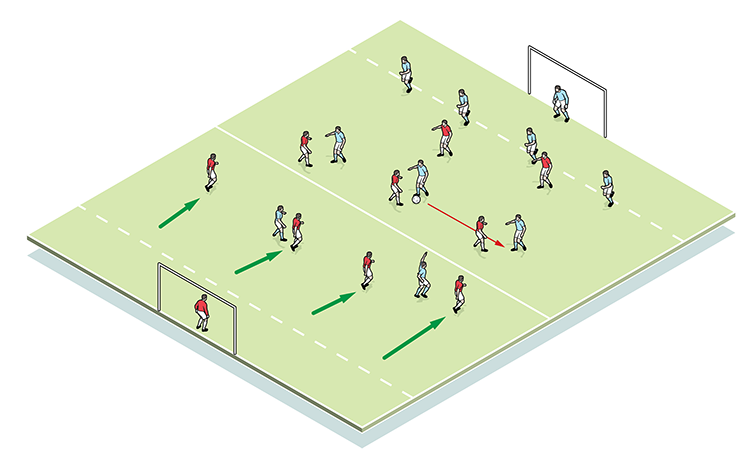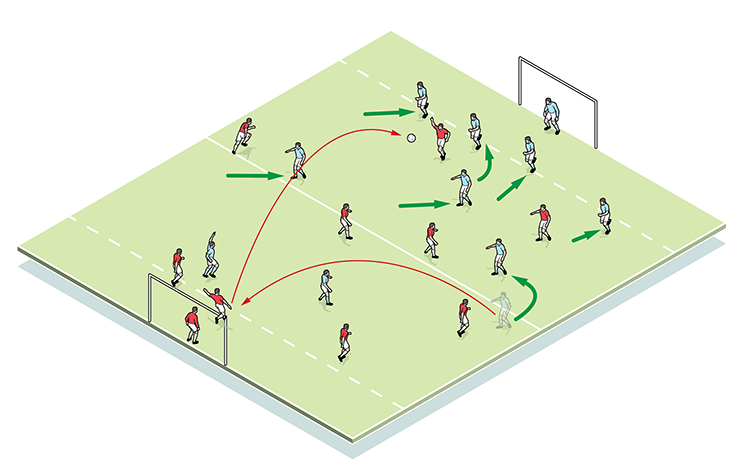You are viewing 1 of your 1 free articles
Clearing defensive danger
| Area | 80x70 yards |
| Equipment | Balls, cones, goal |
| No. of Players | 10v10 including keepers |
| Session Time | Game time: 50mins |
This session is about the reactions and movements of defensive players. It looks primarily at the role of the back four in squeezing up and condensing play as they would do in a match day situation, yet also checks on how players in other areas need to adapt their movements so as to protect the formation as a whole.
It’s crucial that danger is dealt with quickly and effectively in match situations. Although this session provides a setting where any number of scenarios may occur, we are looking for individual and team reactions to whatever develops.
What do I get the players to do?
In an 80x70-yard area (or the space in between the two penalty areas on a standard pitch), we mark 10-yard lines in front of each goal. Defenders should be looking to stay out of these deep defensive zones whenever possible.
In this match-like practice, teams line up 4-3-2. We play this with the tempo and realism of a normal game, adding in conditions designed to bring about events and situations. These include playing at high tempo, encouraging attacking flair, and varying crosses from the wing with play built through the middle. The back four should also be given passing targets to ensure that their methods of removing danger remain varied.
When clearing the ball, the first thought of defenders should be to vacate the 10-yard zone, developing the ball and squeezing play in front of them.
1

2

3

What are the key things to look for technically/tactically?
Crucially, defenders must be communicating at all times to ensure a fluent and organised unit.
When opponents have possession, the emphasis is on defenders to push forward from their marked zone, squeezing play in front of them, with full-backs further forward than centre-backs.
Should play come back into the defenders’ half, they must drop and regroup, with special attention given to tracking wingers and covering runners – this also being a job for midfielders.
The back four need to stay flexible to adapt to challenges. For instance, if the left-back supports the left midfielder then the shape of the team should shift with the right-back moving to the centre-half position.
If a winger is beaten in a one-on-one, his full-back should be ready to press the ball whilst looking for the winger to provide cover by running back diagonally.
Upfield, strikers must decide when to press defenders and when to regain shape. But as soon as the ball gets transferred into the other half, the frontmen must drop back into standard formation.
We find repeating this session rapidly builds understanding between team mates’ actions and intentions.
4

5

6

Related Files
Editor's Picks
Deep runs in the final third
Using the goalkeeper in build-up play
Pressing principles
Intensive boxes drill with goals
Penetrating the final third
Creating and finishing
My philosophy
Pressing initiation
Compact team movement
Coaches' Testimonials

Alan Pardew

Arsène Wenger

Brendan Rodgers

Carlos Carvalhal

José Mourinho

Jürgen Klopp

Pep Guardiola

Roy Hodgson

Sir Alex Ferguson

Steven Gerrard
Coaches' Testimonials

Gerald Kearney, Downtown Las Vegas Soccer Club

Paul Butler, Florida, USA

Rick Shields, Springboro, USA

Tony Green, Pierrefonds Titans, Quebec, Canada
Join the world's leading coaches and managers and discover for yourself one of the best kept secrets in coaching. No other training tool on the planet is written or read by the calibre of names you’ll find in Elite Soccer.
In a recent survey 92% of subscribers said Elite Soccer makes them more confident, 89% said it makes them a more effective coach and 91% said it makes them more inspired.
Get Monthly Inspiration
All the latest techniques and approaches
Since 2010 Elite Soccer has given subscribers exclusive insight into the training ground practices of the world’s best coaches. Published in partnership with the League Managers Association we have unparalleled access to the leading lights in the English leagues, as well as a host of international managers.
Elite Soccer exclusively features sessions written by the coaches themselves. There are no observed sessions and no sessions “in the style of”, just first-hand advice delivered direct to you from the coach.









